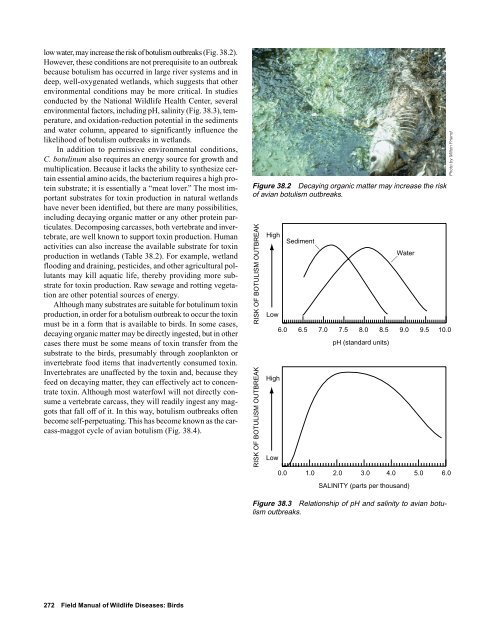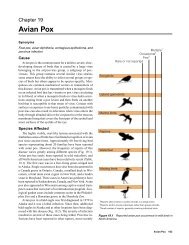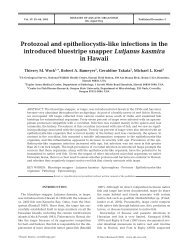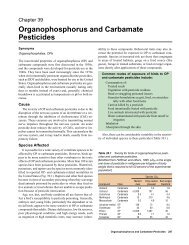Chapter 38 Avian Botulism - National Wildlife Health Center
Chapter 38 Avian Botulism - National Wildlife Health Center
Chapter 38 Avian Botulism - National Wildlife Health Center
Create successful ePaper yourself
Turn your PDF publications into a flip-book with our unique Google optimized e-Paper software.
low water, may increase the risk of botulism outbreaks (Fig. <strong>38</strong>.2).<br />
However, these conditions are not prerequisite to an outbreak<br />
because botulism has occurred in large river systems and in<br />
deep, well-oxygenated wetlands, which suggests that other<br />
environmental conditions may be more critical. In studies<br />
conducted by the <strong>National</strong> <strong>Wildlife</strong> <strong>Health</strong> <strong>Center</strong>, several<br />
environmental factors, including pH, salinity (Fig. <strong>38</strong>.3), temperature,<br />
and oxidation-reduction potential in the sediments<br />
and water column, appeared to significantly influence the<br />
likelihood of botulism outbreaks in wetlands.<br />
In addition to permissive environmental conditions,<br />
C. botulinum also requires an energy source for growth and<br />
multiplication. Because it lacks the ability to synthesize certain<br />
essential amino acids, the bacterium requires a high protein<br />
substrate; it is essentially a “meat lover.” The most important<br />
substrates for toxin production in natural wetlands<br />
have never been identified, but there are many possibilities,<br />
including decaying organic matter or any other protein particulates.<br />
Decomposing carcasses, both vertebrate and invertebrate,<br />
are well known to support toxin production. Human<br />
activities can also increase the available substrate for toxin<br />
production in wetlands (Table <strong>38</strong>.2). For example, wetland<br />
flooding and draining, pesticides, and other agricultural pollutants<br />
may kill aquatic life, thereby providing more substrate<br />
for toxin production. Raw sewage and rotting vegetation<br />
are other potential sources of energy.<br />
Although many substrates are suitable for botulinum toxin<br />
production, in order for a botulism outbreak to occur the toxin<br />
must be in a form that is available to birds. In some cases,<br />
decaying organic matter may be directly ingested, but in other<br />
cases there must be some means of toxin transfer from the<br />
substrate to the birds, presumably through zooplankton or<br />
invertebrate food items that inadvertently consumed toxin.<br />
Invertebrates are unaffected by the toxin and, because they<br />
feed on decaying matter, they can effectively act to concentrate<br />
toxin. Although most waterfowl will not directly consume<br />
a vertebrate carcass, they will readily ingest any maggots<br />
that fall off of it. In this way, botulism outbreaks often<br />
become self-perpetuating. This has become known as the carcass-maggot<br />
cycle of avian botulism (Fig. <strong>38</strong>.4).<br />
Figure <strong>38</strong>.2 Decaying organic matter may increase the risk<br />
of avian botulism outbreaks.<br />
RISK OF BOTULISM OUTBREAK<br />
RISK OF BOTULISM OUTBREAK<br />
High<br />
Sediment<br />
Water<br />
Low<br />
6.0 6.5 7.0 7.5 8.0 8.5 9.0 9.5 10.0<br />
pH (standard units)<br />
High<br />
Low<br />
0.0 1.0 2.0 3.0 4.0 5.0 6.0<br />
SALINITY (parts per thousand)<br />
Photo by Milton Friend<br />
Figure <strong>38</strong>.3 Relationship of pH and salinity to avian botulism<br />
outbreaks.<br />
272 Field Manual of <strong>Wildlife</strong> Diseases: Birds
















